Business Process Engineering: ERP Systems and SAP Implementation
VerifiedAdded on 2023/06/10
|12
|2058
|244
Report
AI Summary
This report provides an overview of Business Process Engineering (BPR) and its relationship with Enterprise Resource Planning (ERP) systems, particularly focusing on SAP implementations. It discusses how BPR involves significant organizational changes, including restructuring management systems, and emphasizes refocusing on customer needs and redesigning core processes. The report contrasts ERP systems with traditional systems like TPS, MIS, and DSS, highlighting ERP's ability to integrate various business processes and improve information flow. It also addresses the importance of data migration and cleansing during ERP implementation, critical success factors, and the role of people in ERP system adoption. The report concludes that ERP systems enhance customer support and improve company processes through better integration, making them beneficial for organizations like Woolworths.
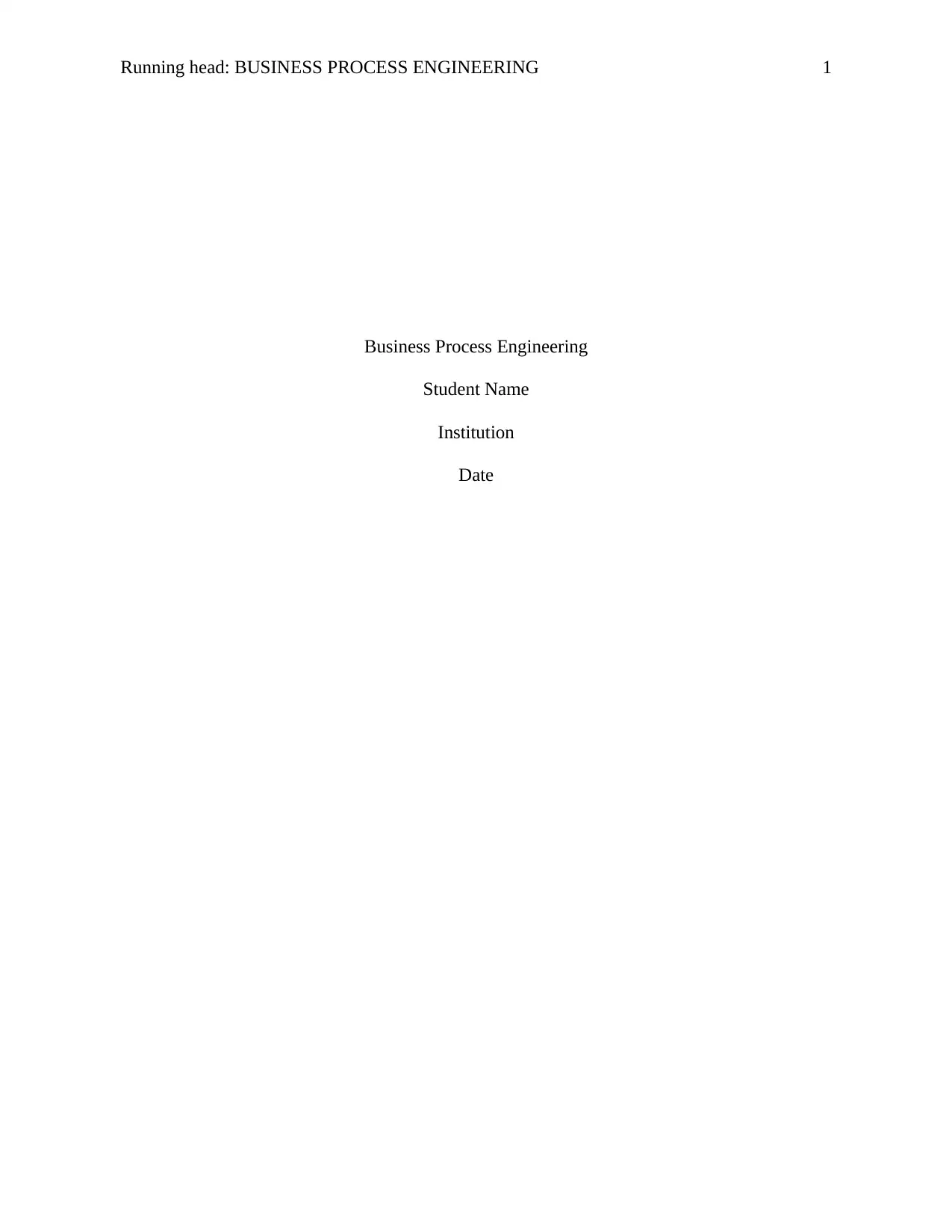
Running head: BUSINESS PROCESS ENGINEERING 1
Business Process Engineering
Student Name
Institution
Date
Business Process Engineering
Student Name
Institution
Date
Paraphrase This Document
Need a fresh take? Get an instant paraphrase of this document with our AI Paraphraser
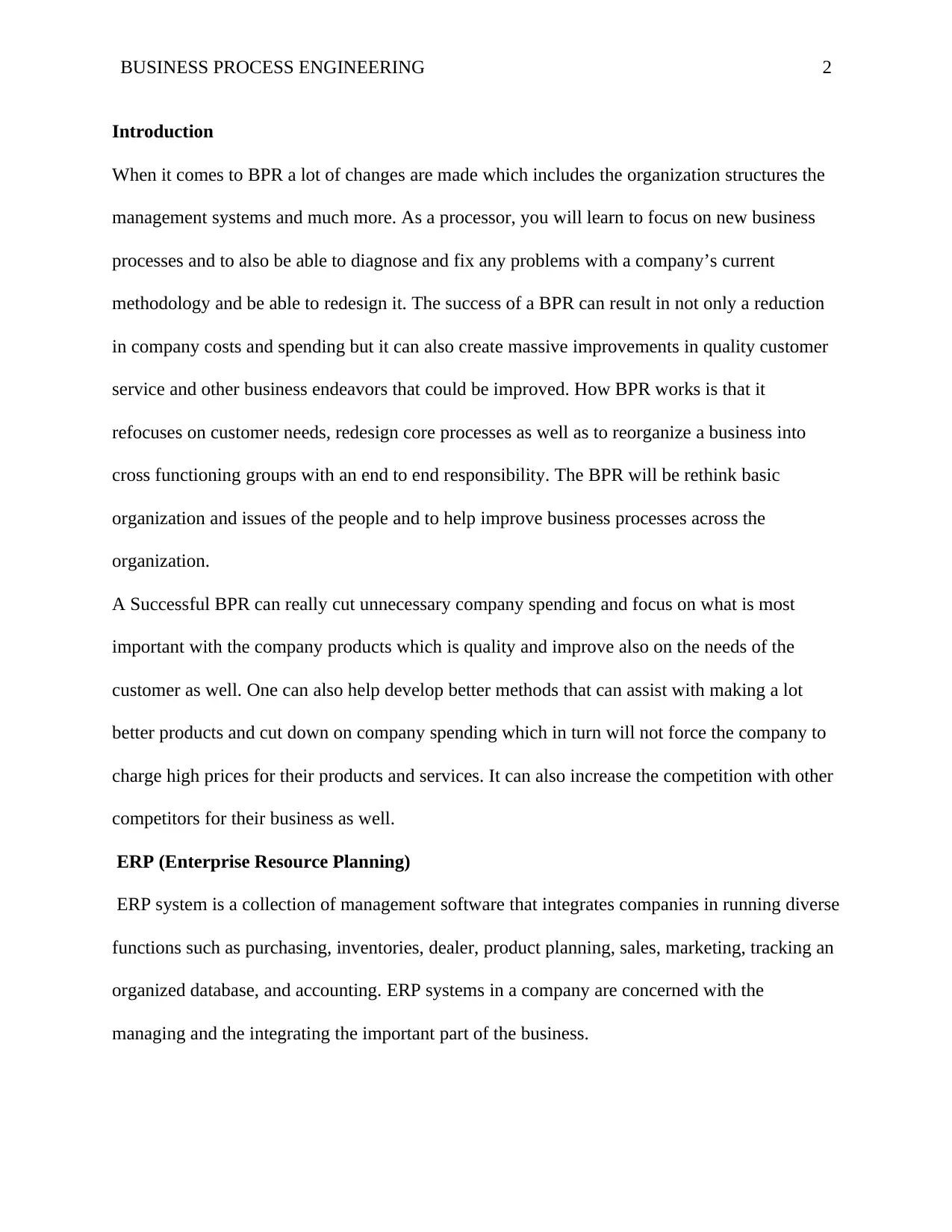
BUSINESS PROCESS ENGINEERING 2
Introduction
When it comes to BPR a lot of changes are made which includes the organization structures the
management systems and much more. As a processor, you will learn to focus on new business
processes and to also be able to diagnose and fix any problems with a company’s current
methodology and be able to redesign it. The success of a BPR can result in not only a reduction
in company costs and spending but it can also create massive improvements in quality customer
service and other business endeavors that could be improved. How BPR works is that it
refocuses on customer needs, redesign core processes as well as to reorganize a business into
cross functioning groups with an end to end responsibility. The BPR will be rethink basic
organization and issues of the people and to help improve business processes across the
organization.
A Successful BPR can really cut unnecessary company spending and focus on what is most
important with the company products which is quality and improve also on the needs of the
customer as well. One can also help develop better methods that can assist with making a lot
better products and cut down on company spending which in turn will not force the company to
charge high prices for their products and services. It can also increase the competition with other
competitors for their business as well.
ERP (Enterprise Resource Planning)
ERP system is a collection of management software that integrates companies in running diverse
functions such as purchasing, inventories, dealer, product planning, sales, marketing, tracking an
organized database, and accounting. ERP systems in a company are concerned with the
managing and the integrating the important part of the business.
Introduction
When it comes to BPR a lot of changes are made which includes the organization structures the
management systems and much more. As a processor, you will learn to focus on new business
processes and to also be able to diagnose and fix any problems with a company’s current
methodology and be able to redesign it. The success of a BPR can result in not only a reduction
in company costs and spending but it can also create massive improvements in quality customer
service and other business endeavors that could be improved. How BPR works is that it
refocuses on customer needs, redesign core processes as well as to reorganize a business into
cross functioning groups with an end to end responsibility. The BPR will be rethink basic
organization and issues of the people and to help improve business processes across the
organization.
A Successful BPR can really cut unnecessary company spending and focus on what is most
important with the company products which is quality and improve also on the needs of the
customer as well. One can also help develop better methods that can assist with making a lot
better products and cut down on company spending which in turn will not force the company to
charge high prices for their products and services. It can also increase the competition with other
competitors for their business as well.
ERP (Enterprise Resource Planning)
ERP system is a collection of management software that integrates companies in running diverse
functions such as purchasing, inventories, dealer, product planning, sales, marketing, tracking an
organized database, and accounting. ERP systems in a company are concerned with the
managing and the integrating the important part of the business.
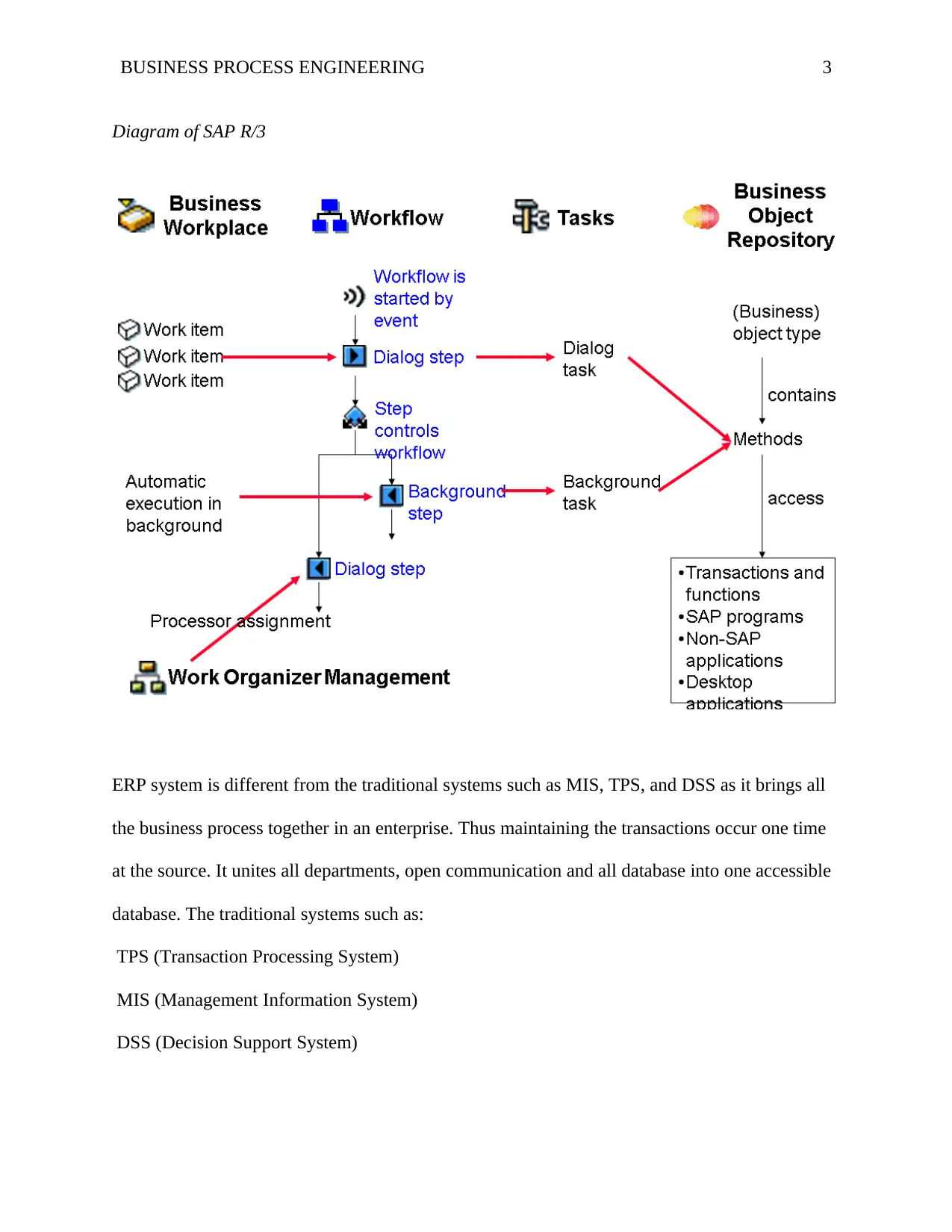
BUSINESS PROCESS ENGINEERING 3
Diagram of SAP R/3
ERP system is different from the traditional systems such as MIS, TPS, and DSS as it brings all
the business process together in an enterprise. Thus maintaining the transactions occur one time
at the source. It unites all departments, open communication and all database into one accessible
database. The traditional systems such as:
TPS (Transaction Processing System)
MIS (Management Information System)
DSS (Decision Support System)
Diagram of SAP R/3
ERP system is different from the traditional systems such as MIS, TPS, and DSS as it brings all
the business process together in an enterprise. Thus maintaining the transactions occur one time
at the source. It unites all departments, open communication and all database into one accessible
database. The traditional systems such as:
TPS (Transaction Processing System)
MIS (Management Information System)
DSS (Decision Support System)
⊘ This is a preview!⊘
Do you want full access?
Subscribe today to unlock all pages.

Trusted by 1+ million students worldwide
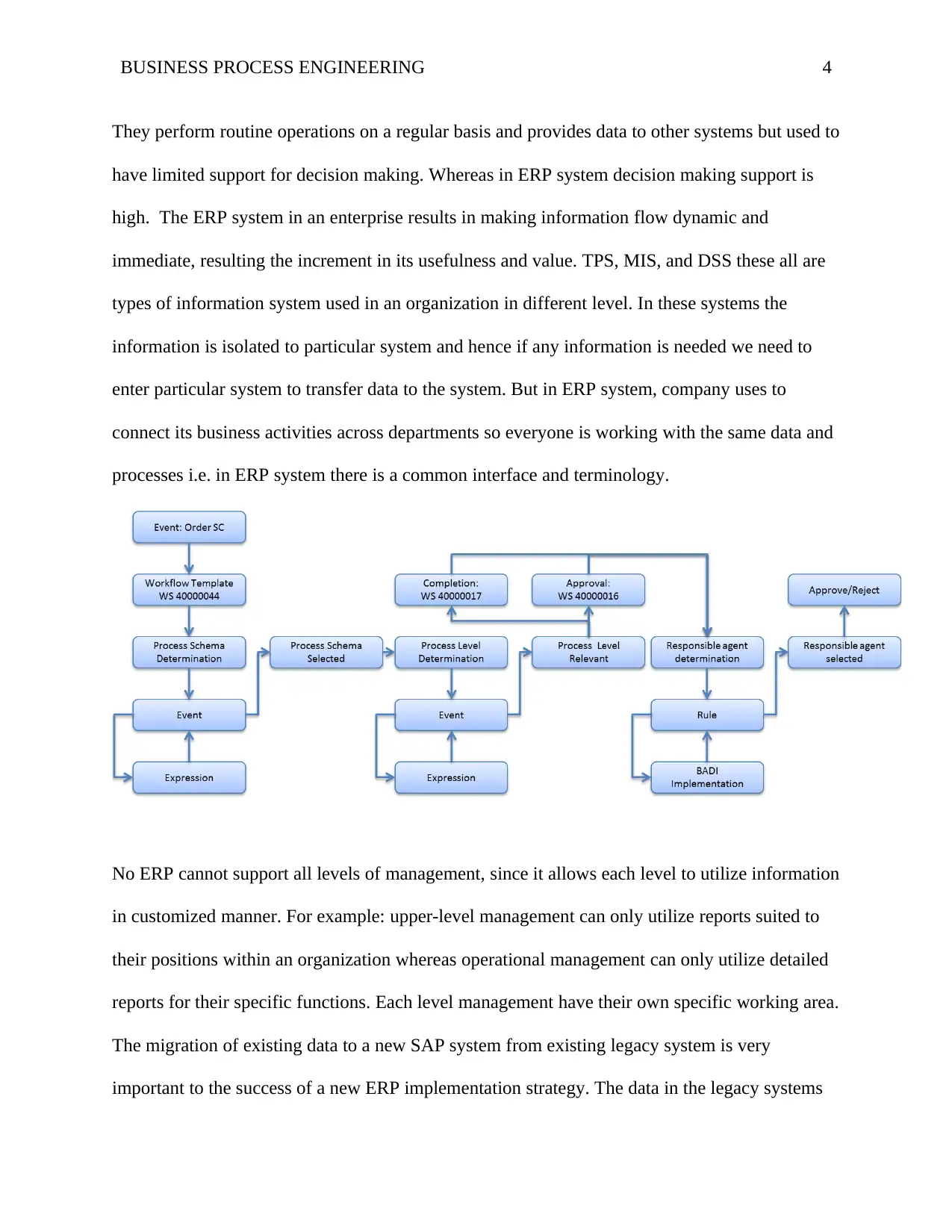
BUSINESS PROCESS ENGINEERING 4
They perform routine operations on a regular basis and provides data to other systems but used to
have limited support for decision making. Whereas in ERP system decision making support is
high. The ERP system in an enterprise results in making information flow dynamic and
immediate, resulting the increment in its usefulness and value. TPS, MIS, and DSS these all are
types of information system used in an organization in different level. In these systems the
information is isolated to particular system and hence if any information is needed we need to
enter particular system to transfer data to the system. But in ERP system, company uses to
connect its business activities across departments so everyone is working with the same data and
processes i.e. in ERP system there is a common interface and terminology.
No ERP cannot support all levels of management, since it allows each level to utilize information
in customized manner. For example: upper-level management can only utilize reports suited to
their positions within an organization whereas operational management can only utilize detailed
reports for their specific functions. Each level management have their own specific working area.
The migration of existing data to a new SAP system from existing legacy system is very
important to the success of a new ERP implementation strategy. The data in the legacy systems
They perform routine operations on a regular basis and provides data to other systems but used to
have limited support for decision making. Whereas in ERP system decision making support is
high. The ERP system in an enterprise results in making information flow dynamic and
immediate, resulting the increment in its usefulness and value. TPS, MIS, and DSS these all are
types of information system used in an organization in different level. In these systems the
information is isolated to particular system and hence if any information is needed we need to
enter particular system to transfer data to the system. But in ERP system, company uses to
connect its business activities across departments so everyone is working with the same data and
processes i.e. in ERP system there is a common interface and terminology.
No ERP cannot support all levels of management, since it allows each level to utilize information
in customized manner. For example: upper-level management can only utilize reports suited to
their positions within an organization whereas operational management can only utilize detailed
reports for their specific functions. Each level management have their own specific working area.
The migration of existing data to a new SAP system from existing legacy system is very
important to the success of a new ERP implementation strategy. The data in the legacy systems
Paraphrase This Document
Need a fresh take? Get an instant paraphrase of this document with our AI Paraphraser
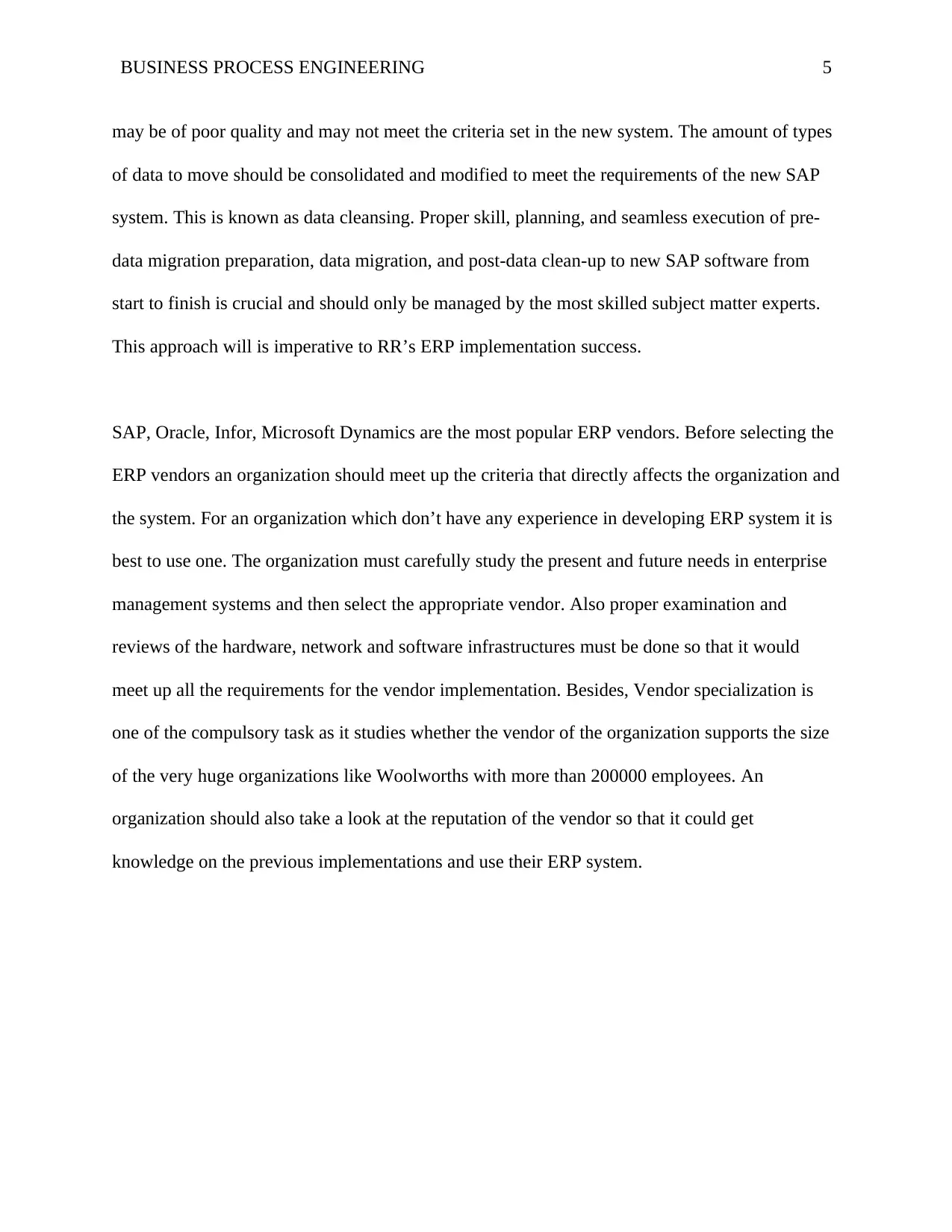
BUSINESS PROCESS ENGINEERING 5
may be of poor quality and may not meet the criteria set in the new system. The amount of types
of data to move should be consolidated and modified to meet the requirements of the new SAP
system. This is known as data cleansing. Proper skill, planning, and seamless execution of pre-
data migration preparation, data migration, and post-data clean-up to new SAP software from
start to finish is crucial and should only be managed by the most skilled subject matter experts.
This approach will is imperative to RR’s ERP implementation success.
SAP, Oracle, Infor, Microsoft Dynamics are the most popular ERP vendors. Before selecting the
ERP vendors an organization should meet up the criteria that directly affects the organization and
the system. For an organization which don’t have any experience in developing ERP system it is
best to use one. The organization must carefully study the present and future needs in enterprise
management systems and then select the appropriate vendor. Also proper examination and
reviews of the hardware, network and software infrastructures must be done so that it would
meet up all the requirements for the vendor implementation. Besides, Vendor specialization is
one of the compulsory task as it studies whether the vendor of the organization supports the size
of the very huge organizations like Woolworths with more than 200000 employees. An
organization should also take a look at the reputation of the vendor so that it could get
knowledge on the previous implementations and use their ERP system.
may be of poor quality and may not meet the criteria set in the new system. The amount of types
of data to move should be consolidated and modified to meet the requirements of the new SAP
system. This is known as data cleansing. Proper skill, planning, and seamless execution of pre-
data migration preparation, data migration, and post-data clean-up to new SAP software from
start to finish is crucial and should only be managed by the most skilled subject matter experts.
This approach will is imperative to RR’s ERP implementation success.
SAP, Oracle, Infor, Microsoft Dynamics are the most popular ERP vendors. Before selecting the
ERP vendors an organization should meet up the criteria that directly affects the organization and
the system. For an organization which don’t have any experience in developing ERP system it is
best to use one. The organization must carefully study the present and future needs in enterprise
management systems and then select the appropriate vendor. Also proper examination and
reviews of the hardware, network and software infrastructures must be done so that it would
meet up all the requirements for the vendor implementation. Besides, Vendor specialization is
one of the compulsory task as it studies whether the vendor of the organization supports the size
of the very huge organizations like Woolworths with more than 200000 employees. An
organization should also take a look at the reputation of the vendor so that it could get
knowledge on the previous implementations and use their ERP system.
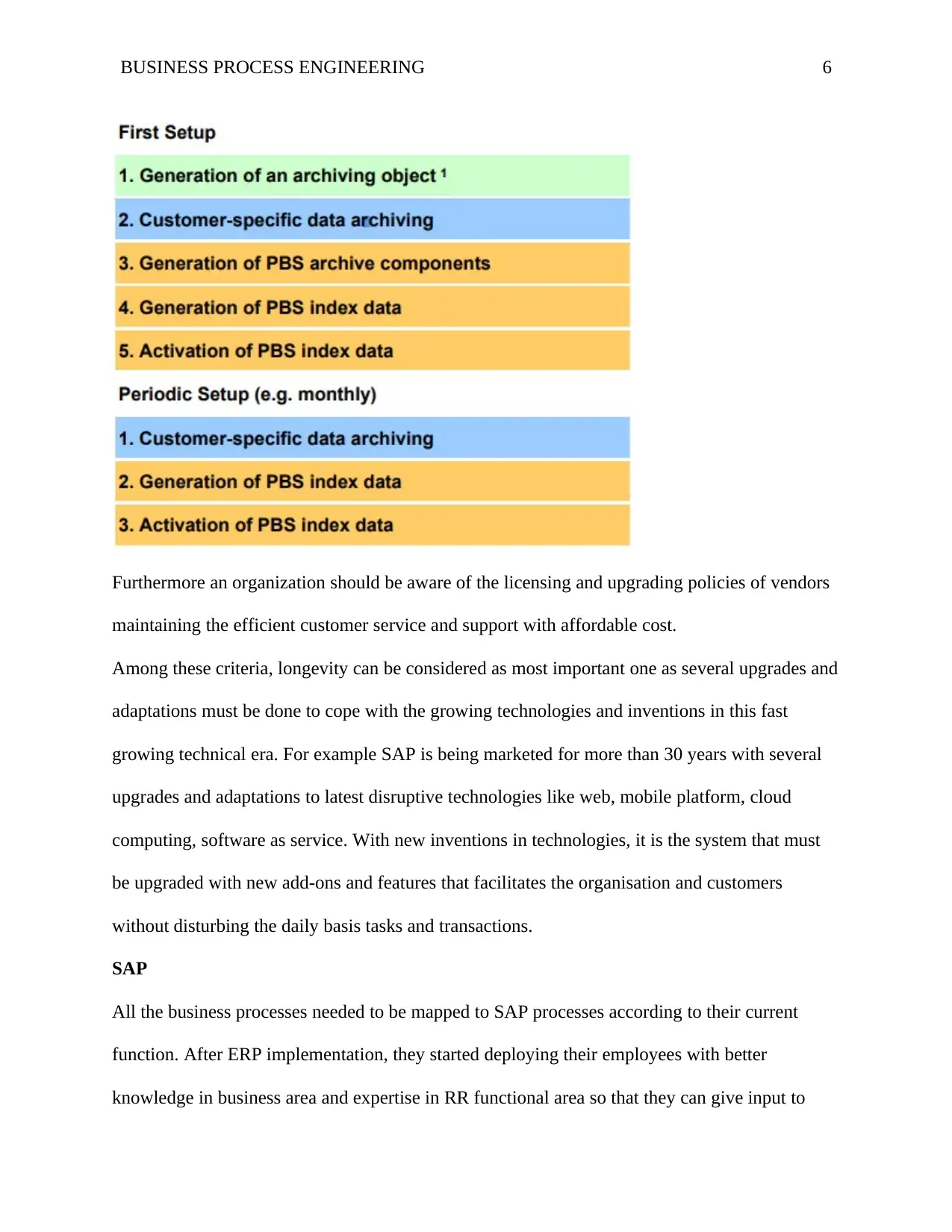
BUSINESS PROCESS ENGINEERING 6
Furthermore an organization should be aware of the licensing and upgrading policies of vendors
maintaining the efficient customer service and support with affordable cost.
Among these criteria, longevity can be considered as most important one as several upgrades and
adaptations must be done to cope with the growing technologies and inventions in this fast
growing technical era. For example SAP is being marketed for more than 30 years with several
upgrades and adaptations to latest disruptive technologies like web, mobile platform, cloud
computing, software as service. With new inventions in technologies, it is the system that must
be upgraded with new add-ons and features that facilitates the organisation and customers
without disturbing the daily basis tasks and transactions.
SAP
All the business processes needed to be mapped to SAP processes according to their current
function. After ERP implementation, they started deploying their employees with better
knowledge in business area and expertise in RR functional area so that they can give input to
Furthermore an organization should be aware of the licensing and upgrading policies of vendors
maintaining the efficient customer service and support with affordable cost.
Among these criteria, longevity can be considered as most important one as several upgrades and
adaptations must be done to cope with the growing technologies and inventions in this fast
growing technical era. For example SAP is being marketed for more than 30 years with several
upgrades and adaptations to latest disruptive technologies like web, mobile platform, cloud
computing, software as service. With new inventions in technologies, it is the system that must
be upgraded with new add-ons and features that facilitates the organisation and customers
without disturbing the daily basis tasks and transactions.
SAP
All the business processes needed to be mapped to SAP processes according to their current
function. After ERP implementation, they started deploying their employees with better
knowledge in business area and expertise in RR functional area so that they can give input to
⊘ This is a preview!⊘
Do you want full access?
Subscribe today to unlock all pages.

Trusted by 1+ million students worldwide

BUSINESS PROCESS ENGINEERING 7
SAP implementation team about the business requirements for better mapping of SAP. As per
RR requirement, the SAP team needed to provide new business process. Even though RR
implemented vanilla implementation of SAP, the technical team had to overcome to avoid the
duplication of data which was RR’s major concern because the reports generated from SAP had
to be precise. Because of ERP implementation selection it helped the business to adopt new
functionality and there was a phase roll out in RR business. They started giving employee a
training to use the new ERP system by adopting training strategy.
The credit for success of RR’s implementation strategy goes to all the team and experts. They
outsourced EDS Company for ER implementation and hired expert ERP consultants from SAP
too. The implement process was divided into small process and team also form to complete the
specific task assigned. SMEs (subject matter experts) and staff with vital knowledge of cross
functional business relationships and experiences of the old legacy system were deployed.
OBU (operations business unit) responsible for implementing work changes and training were
working together with the project team.
SAP implementation team about the business requirements for better mapping of SAP. As per
RR requirement, the SAP team needed to provide new business process. Even though RR
implemented vanilla implementation of SAP, the technical team had to overcome to avoid the
duplication of data which was RR’s major concern because the reports generated from SAP had
to be precise. Because of ERP implementation selection it helped the business to adopt new
functionality and there was a phase roll out in RR business. They started giving employee a
training to use the new ERP system by adopting training strategy.
The credit for success of RR’s implementation strategy goes to all the team and experts. They
outsourced EDS Company for ER implementation and hired expert ERP consultants from SAP
too. The implement process was divided into small process and team also form to complete the
specific task assigned. SMEs (subject matter experts) and staff with vital knowledge of cross
functional business relationships and experiences of the old legacy system were deployed.
OBU (operations business unit) responsible for implementing work changes and training were
working together with the project team.
Paraphrase This Document
Need a fresh take? Get an instant paraphrase of this document with our AI Paraphraser
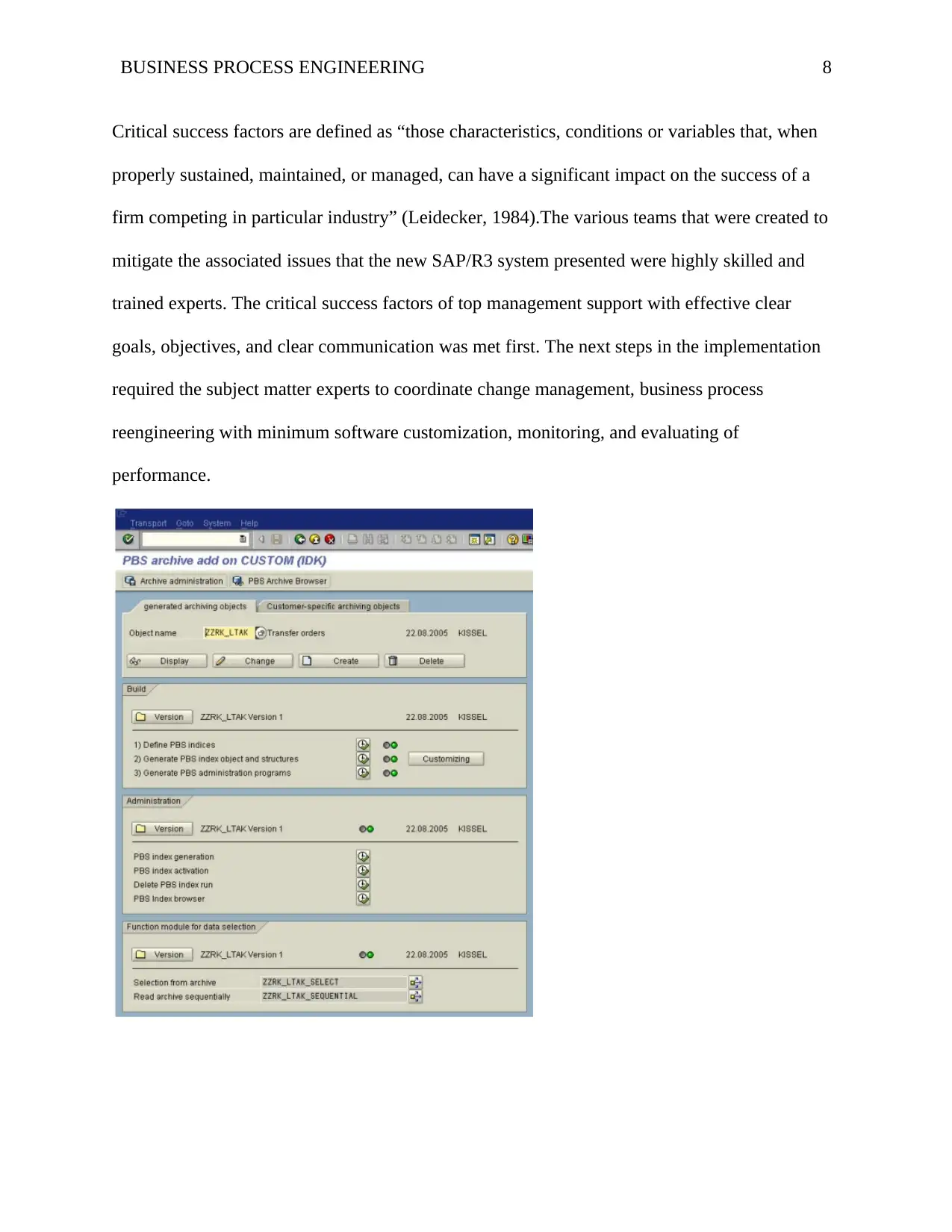
BUSINESS PROCESS ENGINEERING 8
Critical success factors are defined as “those characteristics, conditions or variables that, when
properly sustained, maintained, or managed, can have a significant impact on the success of a
firm competing in particular industry” (Leidecker, 1984).The various teams that were created to
mitigate the associated issues that the new SAP/R3 system presented were highly skilled and
trained experts. The critical success factors of top management support with effective clear
goals, objectives, and clear communication was met first. The next steps in the implementation
required the subject matter experts to coordinate change management, business process
reengineering with minimum software customization, monitoring, and evaluating of
performance.
Critical success factors are defined as “those characteristics, conditions or variables that, when
properly sustained, maintained, or managed, can have a significant impact on the success of a
firm competing in particular industry” (Leidecker, 1984).The various teams that were created to
mitigate the associated issues that the new SAP/R3 system presented were highly skilled and
trained experts. The critical success factors of top management support with effective clear
goals, objectives, and clear communication was met first. The next steps in the implementation
required the subject matter experts to coordinate change management, business process
reengineering with minimum software customization, monitoring, and evaluating of
performance.

BUSINESS PROCESS ENGINEERING 9
⊘ This is a preview!⊘
Do you want full access?
Subscribe today to unlock all pages.

Trusted by 1+ million students worldwide
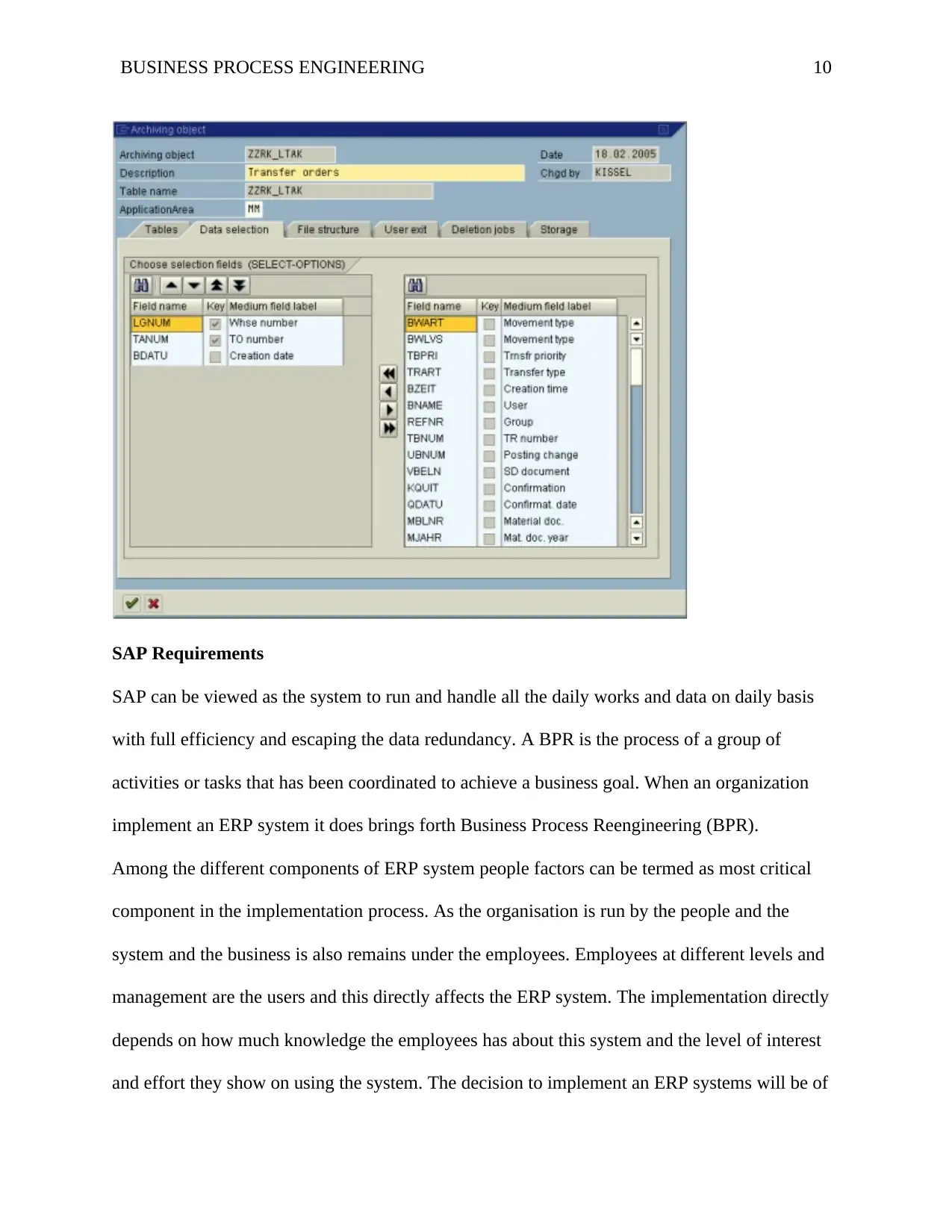
BUSINESS PROCESS ENGINEERING 10
SAP Requirements
SAP can be viewed as the system to run and handle all the daily works and data on daily basis
with full efficiency and escaping the data redundancy. A BPR is the process of a group of
activities or tasks that has been coordinated to achieve a business goal. When an organization
implement an ERP system it does brings forth Business Process Reengineering (BPR).
Among the different components of ERP system people factors can be termed as most critical
component in the implementation process. As the organisation is run by the people and the
system and the business is also remains under the employees. Employees at different levels and
management are the users and this directly affects the ERP system. The implementation directly
depends on how much knowledge the employees has about this system and the level of interest
and effort they show on using the system. The decision to implement an ERP systems will be of
SAP Requirements
SAP can be viewed as the system to run and handle all the daily works and data on daily basis
with full efficiency and escaping the data redundancy. A BPR is the process of a group of
activities or tasks that has been coordinated to achieve a business goal. When an organization
implement an ERP system it does brings forth Business Process Reengineering (BPR).
Among the different components of ERP system people factors can be termed as most critical
component in the implementation process. As the organisation is run by the people and the
system and the business is also remains under the employees. Employees at different levels and
management are the users and this directly affects the ERP system. The implementation directly
depends on how much knowledge the employees has about this system and the level of interest
and effort they show on using the system. The decision to implement an ERP systems will be of
Paraphrase This Document
Need a fresh take? Get an instant paraphrase of this document with our AI Paraphraser
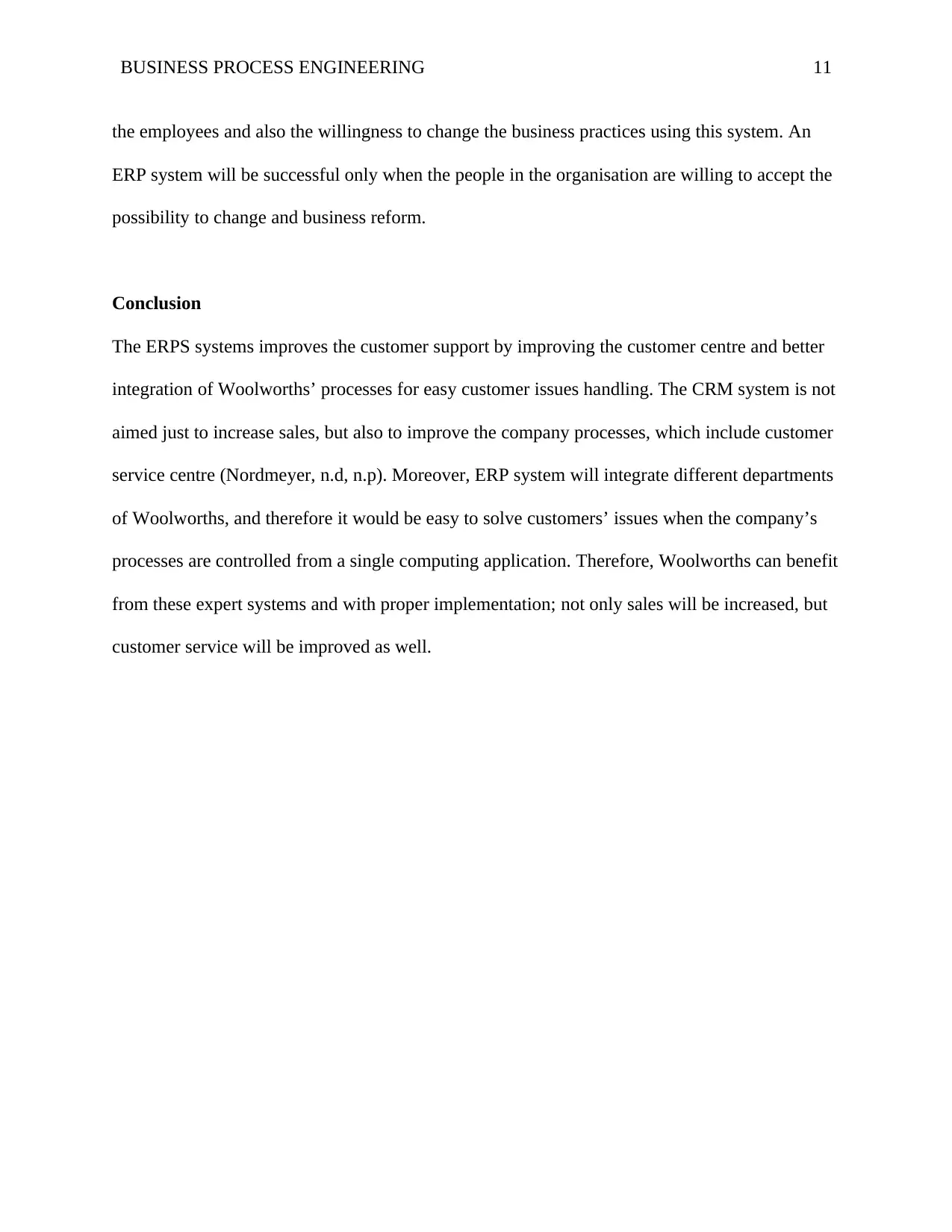
BUSINESS PROCESS ENGINEERING 11
the employees and also the willingness to change the business practices using this system. An
ERP system will be successful only when the people in the organisation are willing to accept the
possibility to change and business reform.
Conclusion
The ERPS systems improves the customer support by improving the customer centre and better
integration of Woolworths’ processes for easy customer issues handling. The CRM system is not
aimed just to increase sales, but also to improve the company processes, which include customer
service centre (Nordmeyer, n.d, n.p). Moreover, ERP system will integrate different departments
of Woolworths, and therefore it would be easy to solve customers’ issues when the company’s
processes are controlled from a single computing application. Therefore, Woolworths can benefit
from these expert systems and with proper implementation; not only sales will be increased, but
customer service will be improved as well.
the employees and also the willingness to change the business practices using this system. An
ERP system will be successful only when the people in the organisation are willing to accept the
possibility to change and business reform.
Conclusion
The ERPS systems improves the customer support by improving the customer centre and better
integration of Woolworths’ processes for easy customer issues handling. The CRM system is not
aimed just to increase sales, but also to improve the company processes, which include customer
service centre (Nordmeyer, n.d, n.p). Moreover, ERP system will integrate different departments
of Woolworths, and therefore it would be easy to solve customers’ issues when the company’s
processes are controlled from a single computing application. Therefore, Woolworths can benefit
from these expert systems and with proper implementation; not only sales will be increased, but
customer service will be improved as well.
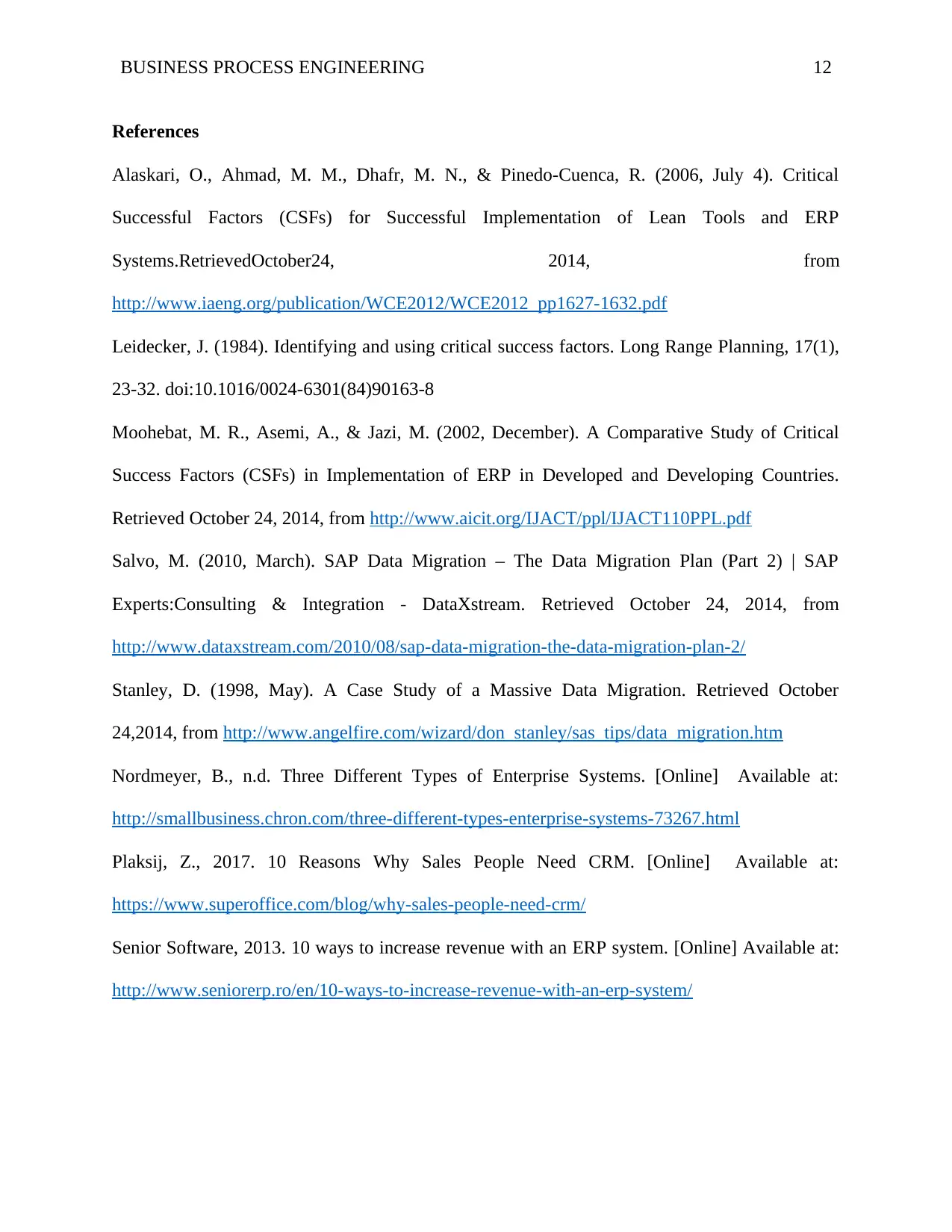
BUSINESS PROCESS ENGINEERING 12
References
Alaskari, O., Ahmad, M. M., Dhafr, M. N., & Pinedo-Cuenca, R. (2006, July 4). Critical
Successful Factors (CSFs) for Successful Implementation of Lean Tools and ERP
Systems.RetrievedOctober24, 2014, from
http://www.iaeng.org/publication/WCE2012/WCE2012_pp1627-1632.pdf
Leidecker, J. (1984). Identifying and using critical success factors. Long Range Planning, 17(1),
23-32. doi:10.1016/0024-6301(84)90163-8
Moohebat, M. R., Asemi, A., & Jazi, M. (2002, December). A Comparative Study of Critical
Success Factors (CSFs) in Implementation of ERP in Developed and Developing Countries.
Retrieved October 24, 2014, from http://www.aicit.org/IJACT/ppl/IJACT110PPL.pdf
Salvo, M. (2010, March). SAP Data Migration – The Data Migration Plan (Part 2) | SAP
Experts:Consulting & Integration - DataXstream. Retrieved October 24, 2014, from
http://www.dataxstream.com/2010/08/sap-data-migration-the-data-migration-plan-2/
Stanley, D. (1998, May). A Case Study of a Massive Data Migration. Retrieved October
24,2014, from http://www.angelfire.com/wizard/don_stanley/sas_tips/data_migration.htm
Nordmeyer, B., n.d. Three Different Types of Enterprise Systems. [Online] Available at:
http://smallbusiness.chron.com/three-different-types-enterprise-systems-73267.html
Plaksij, Z., 2017. 10 Reasons Why Sales People Need CRM. [Online] Available at:
https://www.superoffice.com/blog/why-sales-people-need-crm/
Senior Software, 2013. 10 ways to increase revenue with an ERP system. [Online] Available at:
http://www.seniorerp.ro/en/10-ways-to-increase-revenue-with-an-erp-system/
References
Alaskari, O., Ahmad, M. M., Dhafr, M. N., & Pinedo-Cuenca, R. (2006, July 4). Critical
Successful Factors (CSFs) for Successful Implementation of Lean Tools and ERP
Systems.RetrievedOctober24, 2014, from
http://www.iaeng.org/publication/WCE2012/WCE2012_pp1627-1632.pdf
Leidecker, J. (1984). Identifying and using critical success factors. Long Range Planning, 17(1),
23-32. doi:10.1016/0024-6301(84)90163-8
Moohebat, M. R., Asemi, A., & Jazi, M. (2002, December). A Comparative Study of Critical
Success Factors (CSFs) in Implementation of ERP in Developed and Developing Countries.
Retrieved October 24, 2014, from http://www.aicit.org/IJACT/ppl/IJACT110PPL.pdf
Salvo, M. (2010, March). SAP Data Migration – The Data Migration Plan (Part 2) | SAP
Experts:Consulting & Integration - DataXstream. Retrieved October 24, 2014, from
http://www.dataxstream.com/2010/08/sap-data-migration-the-data-migration-plan-2/
Stanley, D. (1998, May). A Case Study of a Massive Data Migration. Retrieved October
24,2014, from http://www.angelfire.com/wizard/don_stanley/sas_tips/data_migration.htm
Nordmeyer, B., n.d. Three Different Types of Enterprise Systems. [Online] Available at:
http://smallbusiness.chron.com/three-different-types-enterprise-systems-73267.html
Plaksij, Z., 2017. 10 Reasons Why Sales People Need CRM. [Online] Available at:
https://www.superoffice.com/blog/why-sales-people-need-crm/
Senior Software, 2013. 10 ways to increase revenue with an ERP system. [Online] Available at:
http://www.seniorerp.ro/en/10-ways-to-increase-revenue-with-an-erp-system/
⊘ This is a preview!⊘
Do you want full access?
Subscribe today to unlock all pages.

Trusted by 1+ million students worldwide
1 out of 12
Related Documents
Your All-in-One AI-Powered Toolkit for Academic Success.
+13062052269
info@desklib.com
Available 24*7 on WhatsApp / Email
![[object Object]](/_next/static/media/star-bottom.7253800d.svg)
Unlock your academic potential
Copyright © 2020–2025 A2Z Services. All Rights Reserved. Developed and managed by ZUCOL.





